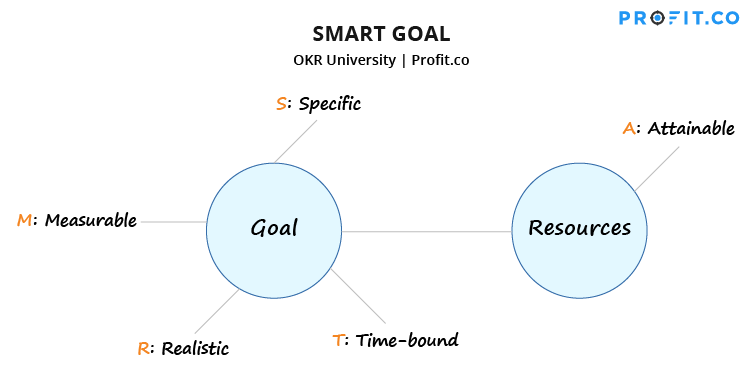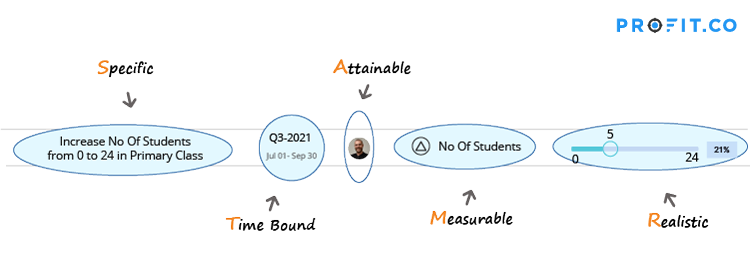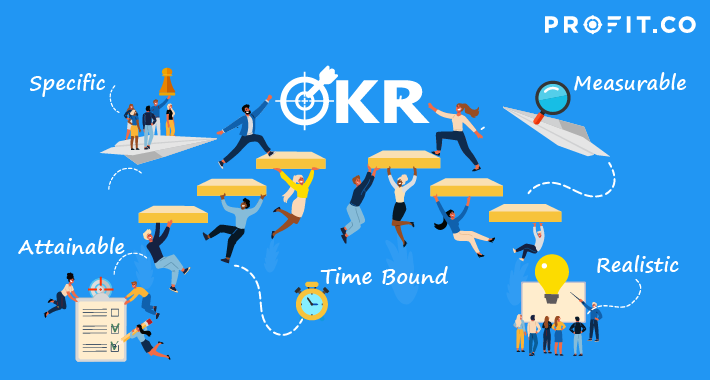Anyone looking to learn more about properly setting and managing goals has probably read about SMART goals. Here’s a refresh: SMART is an acronym to help you set plausible goals for you and your team. This stands for: Specific, Measurable, Attainable, Realistic, and Time-bound.
Setting goals is the first step in turning the invisible into the visible.
Additionally, you have probably read about the OKR framework. Objectives and Key Results are a strategy-execution framework used by companies of all sizes and in all industries to better focus their limited time and resources on what will impact their business most. Industry-leading companies like Google, Amazon, and Netflix have brought this framework to light in recent years, and more and more companies are managing their important goals with OKRs.
The more you read about key results and SMART goals, you may start to recognize the similarities between the two.
SMART Goals
Let’s take a closer look at each requirement of a SMART goal.

- S: Specific: The target is unambiguous for everyone to see.
- M: Measurable: The target’s progress can be measured.
- A: Attainable: There are enough people and resources to achieve the target.
- R: Realistic: The target is not impossible to achieve.
- T: Time-bound: The target has a strict, clear deadline.
S– Specific
Making your goal specific means that there should be no ambiguity about the topic or extent of your goal. Anyone reading it should be able to tell what your goal is, precisely. For example, if you have a goal to grow annual recurring revenue (ARR), you should not simply write your goal as: “Grow ARR”. Instead, you should provide a specific number. For example, “Grow ARR to $4M”.
M– Measurable
Ensuring that your goal is measurable is an important part of staying on track each and every week. You will not be able to determine when you achieve your goal if you cannot measure it. So, when setting a goal, you should specify what you are measuring– such as the number of leads, or number of conversions. It’s a good idea to use your department or team’s important KPIs to get an accurate idea of how your goal is progressing. On a weekly basis, you can count your progress and track your progress towards your goal.
A– Attainable
When you set goals, they should always be attainable with what your team, department, or organization has on hand. This attribute speaks towards the capacity of your employees and capability of resources that you have available in your organization at this point. If you have a goal that is specific and measurable, but you don’t have any employees available to work on it, or don’t have the budget to execute it, then the goal isn’t useful– and it won’t succeed.
R– Realistic
While the attributes “attainable” and “realistic” may sound like synonyms, they address unique characteristics of a goal. While the achievability of a goal refers to how attainable it is with the resources of the organization, the attribute “realistic” refers to the target itself. Has the department or team assigned to this goal completed something like this in the past? Will they have a tried and true method to achieve this target? Or are they starting from scratch? Is there a precedent that can tell your team this target is realistic for them?
T– Time-bound
Finally, you need to ensure that your goal has a distinct deadline that adds urgency and importance to the target. While you might have a goal to revamp your marketing materials, very little will be accomplished if you do not have a deadline to prompt yourself and others to get moving on what needs to be done.
Goals should meet all of the requirements outlined by the SMART acronym. These characteristics build on one another to create a solid goal that is informative, unambiguous, time-bound, and measurable. If you meet all of these attributes, you’ll have a solid, well-structured goal.
If you want an agile OKR software that helps you write strong OKRs and maintain transparency and alignment all quarter long, sign up for Profit.co’s OKR software free today!
Key Results
Key results are the quantitative outcomes that help measure the success of objectives in your OKR program. Many OKR champions report struggling with learning to write solid, well-structured key results in the early stages of their OKR program– SMART goals can actually help with this.
Let’s take a look at a high-quality key result:
Increase the number of students enrolled in primary class from 0 to 24 in Q3.

Already, you can probably tell that this key result has met many of the requirements of a SMART goal. First, this key result is specific and unambiguous– by simply reading the goal, you know what must be achieved.
It is also measurable, with a clear metric– the number of students– you can track over a period of time.
Third, it is attainable, meaning that this key result can be assigned to an individual who will be responsible for enrolling students.
Fourth, is this key result realistic? We would need some background information on the owner of the key result, however if there’s a precedent, and a similar goal has been set and achieved before, or seems feasible given the company’s history, the answer is yes.
Finally, this key result specifies it should be completed within quarter three– a reasonable timeframe for a key result that’s set at the beginning of your quarter.
This key result meets all the requirements of SMART goals. In fact, all great key results will qualify as SMART goals– however, not all of the SMART goals you write will make good key results.
Key results have another requirement that other SMART goals don’t– they must be informed by the higher level goals of the organization or department and account for any alignments or dependencies. While individual entrepreneurs might use SMART goals to keep their personal or professional development on track, organizations need to use a goal-setting process that is attentive to the strategy, resources, and trajectory of the company as a whole.
To account for these things, it’s wise to set key results based on lagging or leading KPIs, so your team is measuring what matters most for your business success. Key results can also be output-based or even address non-measurables such as hiring a new department head or creating a new onboarding system. Regardless of the metrics used in your key results, you still must address the five attributes of a SMART goal. From there, you can align targets and track targets knowing that you have a well-written and well-structured goal.
Final Thoughts
While SMART goals and key results aren’t technically one in the same, it’s useful for you, as an OKR champion, to know how to write and structure both of these targets. The required attributes that make a SMART goal are characteristics you need to include in each and every key result you write for yourself or others on your team. This ensures that anyone who reads the key result will get all of the information they need to start working on what matters most.
To learn how to write strong objectives and specific, well-structured key results on an intuitive OKR software, book a free demo with the OKR experts at Profit.co today!
Ready to start your OKR Journey for FREE?

